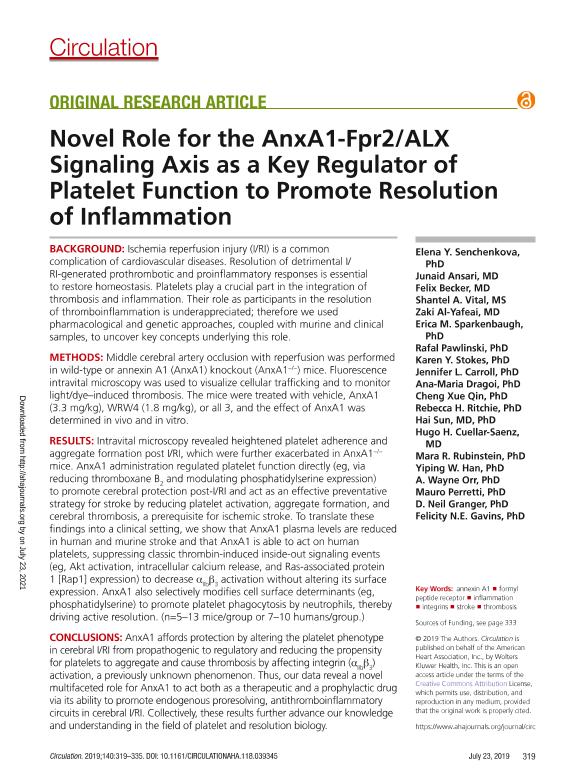Artículo
Novel Role for the AnxA1-Fpr2/ALX Signaling Axis as a Key Regulator of Platelet Function to Promote Resolution of Inflammation
Senchenkova, Elena Y.; Ansari, Junaid; Becker, Felix; Vital, Shantel A.; Al-Yafeai, Zaki; Sparkenbaugh, Erica M.; Pawlinski, Rafal; Stokes, Karen Y.; Carroll, Jennifer L.; Dragoi, Ana-Maria; Qin, Cheng Xue; Ritchie, Rebecca H.; Sun, Hai; Cuellar-Saenz, Hugo H.; Rubinstein Guichon, Mara Roxana ; Han, Yiping W.; Orr, A. Wayne; Perretti, Mauro; Granger, D. Neil; Gavins, Felicity N.E.
; Han, Yiping W.; Orr, A. Wayne; Perretti, Mauro; Granger, D. Neil; Gavins, Felicity N.E.
 ; Han, Yiping W.; Orr, A. Wayne; Perretti, Mauro; Granger, D. Neil; Gavins, Felicity N.E.
; Han, Yiping W.; Orr, A. Wayne; Perretti, Mauro; Granger, D. Neil; Gavins, Felicity N.E.
Fecha de publicación:
07/2019
Editorial:
Lippincott Williams
Revista:
Circulation
ISSN:
0009-7322
Idioma:
Inglés
Tipo de recurso:
Artículo publicado
Clasificación temática:
Resumen
Background: Ischemia reperfusion injury (I/RI) is a common complication of cardiovascular diseases. Resolution of detrimental I/RI-generated prothrombotic and proinflammatory responses is essential to restore homeostasis. Platelets play a crucial part in the integration of thrombosis and inflammation. Their role as participants in the resolution of thromboinflammation is underappreciated; therefore we used pharmacological and genetic approaches, coupled with murine and clinical samples, to uncover key concepts underlying this role. Methods: Middle cerebral artery occlusion with reperfusion was performed in wild-type or annexin A1 (AnxA1) knockout (AnxA1-/-) mice. Fluorescence intravital microscopy was used to visualize cellular trafficking and to monitor light/dye-induced thrombosis. The mice were treated with vehicle, AnxA1 (3.3 mg/kg), WRW4 (1.8 mg/kg), or all 3, and the effect of AnxA1 was determined in vivo and in vitro. Results: Intravital microscopy revealed heightened platelet adherence and aggregate formation post I/RI, which were further exacerbated in AnxA1-/- mice. AnxA1 administration regulated platelet function directly (eg, via reducing thromboxane B2 and modulating phosphatidylserine expression) to promote cerebral protection post-I/RI and act as an effective preventative strategy for stroke by reducing platelet activation, aggregate formation, and cerebral thrombosis, a prerequisite for ischemic stroke. To translate these findings into a clinical setting, we show that AnxA1 plasma levels are reduced in human and murine stroke and that AnxA1 is able to act on human platelets, suppressing classic thrombin-induced inside-out signaling events (eg, Akt activation, intracellular calcium release, and Ras-associated protein 1 [Rap1] expression) to decrease IIbβ3 activation without altering its surface expression. AnxA1 also selectively modifies cell surface determinants (eg, phosphatidylserine) to promote platelet phagocytosis by neutrophils, thereby driving active resolution. (n=5-13 mice/group or 7-10 humans/group.) Conclusions: AnxA1 affords protection by altering the platelet phenotype in cerebral I/RI from propathogenic to regulatory and reducing the propensity for platelets to aggregate and cause thrombosis by affecting integrin (IIbβ3) activation, a previously unknown phenomenon. Thus, our data reveal a novel multifaceted role for AnxA1 to act both as a therapeutic and a prophylactic drug via its ability to promote endogenous proresolving, antithromboinflammatory circuits in cerebral I/RI. Collectively, these results further advance our knowledge and understanding in the field of platelet and resolution biology.
Palabras clave:
ANNEXIN A1
,
FORMYL PEPTIDE RECEPTOR
,
INFLAMMATION
,
INTEGRINS
,
STROKE
,
THROMBOSIS
Archivos asociados
Licencia
Identificadores
Colecciones
Articulos(BIOMED)
Articulos de INSTITUTO DE INVESTIGACIONES BIOMEDICAS
Articulos de INSTITUTO DE INVESTIGACIONES BIOMEDICAS
Citación
Senchenkova, Elena Y.; Ansari, Junaid; Becker, Felix; Vital, Shantel A.; Al-Yafeai, Zaki; et al.; Novel Role for the AnxA1-Fpr2/ALX Signaling Axis as a Key Regulator of Platelet Function to Promote Resolution of Inflammation; Lippincott Williams; Circulation; 140; 4; 7-2019; 319-335
Compartir
Altmétricas



